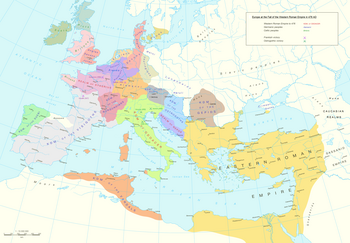Kingdom of the Burgundians
Kingdom of the Burgundians Regnum Burgundionum ( Latin)[1] | |||||||||
|---|---|---|---|---|---|---|---|---|---|
| 411–534 | |||||||||
 The First Kingdom of the Burgundians, after the settlement in Eastern Gaul from 443 | |||||||||
| Capital |
| ||||||||
| Common languages |
| ||||||||
| Religion |
| ||||||||
| Government | Godomar | ||||||||
| History | |||||||||
• | 534 | ||||||||
| |||||||||
| Today part of | |||||||||
The Kingdom of the Burgundians (
History
Background
The Burgundians, a Germanic tribe, may have migrated from the Scandinavian island of Bornholm to the Vistula basin in the 3rd century AD. However, the first documented King of the Burgundians, Gjúki (Gebicca), lived in the late 4th century east of the Rhine.
In 406 the
Kingdom
In 411 AD, the Burgundian king
Despite their new status as foederati, Burgundian raids into Roman upper
Gunther was succeeded as king by
When Gunderic died in 473, his kingdom was divided among his four sons: Gundobad (473–516 in Lyon, king of all of Burgundy from 480), Chilperic II (473–493 in Valence), Gundomar/Godomar (473–486 in Vienne) and Godegisel (473–500, in Vienne and Geneva).

After the fall of the Western Roman Empire in 476, King
According to
List of kings
- Gebicca(late 4th century – c. 407)
- Gundomar I(c. 407 – 411), son of Gebicca
- Giselher (c. 407 – 411), son of Gebicca
- Gunther(c. 407 – 436), son of Gebicca
- Gunderic/Gundioc(436–473) opposed by
- Chilperic I, brother of Gundioc (443–c. 480)
- division of the kingdom among the four sons of Gundioc:
- Gundobad (473–516 in Lyon, king of all of Burgundy from 480),
- Chilperic II (473–493 in Valence)
- Gundomar/Godomar (473–486 in Vienne)
- Godegisel (473–500, in Vienne and Geneva)
- Sigismund, son of Gundobad (516–524)
- Godomar II or Gundimar, son of Gundobad (524–532)
References
- ^ Hallam, Henry (1871). View of the State of Europe During the Middle Ages by Henry Hallam, Incorporating in the Text Authorʼs Latest Researches, with Addidions from Recent Writers, and Adapted to the Use of Students. J. Murray. p. 63.
- ^ Prosper, a. 386
- ^ Prosper; Chronica Gallica 452; Hydatius; and Sidonius Apollinaris.
- ^ Chisholm 1911.
Sources
- Bury, J.B. The Invasion of Europe by the Barbarians. London: Macmillan and Co., 1928.
- Chisholm, Hugh, ed. (1911). . Encyclopædia Britannica (11th ed.). Cambridge University Press.
- Dalton, O.M.The History of the Franks, by Gregory of Tours. Oxford: The Clarendon Press, 1927.
- Drew, Katherine Fischer. The Burgundian Code. Philadelphia: University of Pennsylvania Press, 1972.
- Gordon, C.D. The Age of Attila. Ann Arbor: University of Michigan Press, 1961.
- Guichard, Rene, Essai sur l'histoire du peuple burgonde, de Bornholm (Burgundarholm) vers la Bourgogne et les Bourguignons, 1965, published by A. et J. Picard et Cie.
- Murray, Alexander Callander. From Roman to Merovingian Gaul. Broadview Press, 2000.
- Musset, Lucien. The Germanic Invasions: The Making of Europe AD 400-600. University Park, Pennsylvania: The Pennsylvania State University Press, 1975.
- Nerman, Birger. Det svenska rikets uppkomst. Generalstabens litagrafiska anstalt: Stockholm. 1925.
- Rivers, Theodore John. Laws of the Salian and Ripuarian Franks. New York: AMS Press, 1986.
- Rolfe, J.C., trans, Ammianus Marcellinus. Cambridge, Massachusetts: Harvard University Press, 1950.
- Shanzer, Danuta. ‘Dating the Baptism of Clovis.’ In Early Medieval Europe, volume 7, pages 29–57. Oxford: Blackwell Publishers Ltd, 1998.
- Shanzer, D. and I. Wood. Avitus of Vienne: Letters and Selected Prose. Translated with an Introduction and Notes. Liverpool: Liverpool University Press, 2002.
- Werner, J. (1953). "Beiträge zur Archäologie des Attila-Reiches", Die Bayerische Akademie der Wissenschaft. Abhandlungen. N.F. XXXVIII A Philosophische-philologische und historische Klasse. Münche
- Wood, Ian N. ‘Ethnicity and the Ethnogenesis of the Burgundians’. In Herwig Wolfram and Walter Pohl, editors, Typen der Ethnogenese unter besonderer Berücksichtigung der Bayern, volume 1, pages 53–69. Vienna: Denkschriften der Österreichische Akademie der Wissenschaften, 1990.
- Wood, Ian N. The Merovingian Kingdoms. Harlow, England: The Longman Group, 1994.
